Notes on the Royal Papyrus of Turin
Wolfgang Helck
1992
Since the publication in 1959 of Gardiner's transcription of the Royal Papyrus of Turin, some questions have arisen and corrections and new proposals have come from various quarters. These are scattered in several places, so it might be useful to give a summary. It turns out, that further proposals are possible, which result from a new consideration of the previous arrangement of the fragments, as well as from an attempt to place to the previously unplaced fragments. First, the verso of the papyrus will be examined, i.e. the list of kings, column by column. However, since the fragments cannot be arranged without taking into account the calculations of the front side, the text of the recto should also be briefly discussed at the end.
Column I
The starting point is a consideration of the lines Gardiner counts as I 21-24 and which sum up the list of gods. Line 22 begins with "total [kings] 9", a comparison with other summations and dynastic headings (which are summarized as excursus at the end of the article) shows that "total" always lists predecessors, but never a heading. Therefore we must not begin with Farina Papiro dei re, 17, or Kaiser, in: ZÄS 86, 1961, 57, as an addition: "altogether [Kings] 9 [who (came) after] King Horus", but we must refer the number "9" to the aforementioned gods. Of these, Geb, Osiris, Seth, Horus, Thoth, Maat and Har(oeris?), i.e. the gods of the Heliopolitan Ennead are named first, but the female members are omitted, for whom other gods are introduced at the end of the list. Thus it is clear that we have to insert two names before the preserved Geb, namely Re and Shu.
The summation in lines 22-23 can only read: "total [kings] 9; [their reign from ki]ng Re [to] king Har[oeris] ...". However, with this it becomes immediately clear where frgm. 141 belongs, which Gardiner (see note ad loc. on p. 15) had banished from his previous position above frgm. 11. Gardiner rightly pointed out that the front of this fragment can in no way fit the recto of frgm. 11, since it shows a long line where one necessarily expects a text. Now, this line fits very well into the two other long lines, which are recognizable on the recto on frgm. 11 between the text columns.
These strokes are certainly overlong "tails" of hundred-signs from Col. VI of the recto, where the tail meets line VII x+5 belonging to row 17 of Col. VI, like the tail which ends at the same level of line 7 belong to VI 21, where a 300 is preserved; I would like to connect the stroke of frgm. 141 with VI 26, where eye make-up is accounted for.
A graphic reconstruction of the lines indicates that the scribe broke off the entry shortly before the edge of Col. II on the verso and continued the text in line 33 (see illustration "Col. I"). In line 21 the following should be added: "total their lifetime ..." not as Gardiner suggests, their "years", since the gap is too large for the latter addition. In line 23, the reference to "omitted" years is to be inserted into the indication of the reigns, not only because otherwise the line would have no content, because the total sum follows in line 24, but because in line 14 at Geb we find a long line that protrudes into Col. II at its end. This can only be explained by a notation about "omitted" years and perhaps even an additional summation.
In summary, I would like to complete lines 21-24:
21. Total: their [life] time [years x ............]
22. Total: [kings] 9 [their reign from Ki]ng Re [to]
23. King Har[oeris] [years x, months y, days z, omitted years x, months 10, days 28]
24. [Total:] years x7718 [months y, days z]
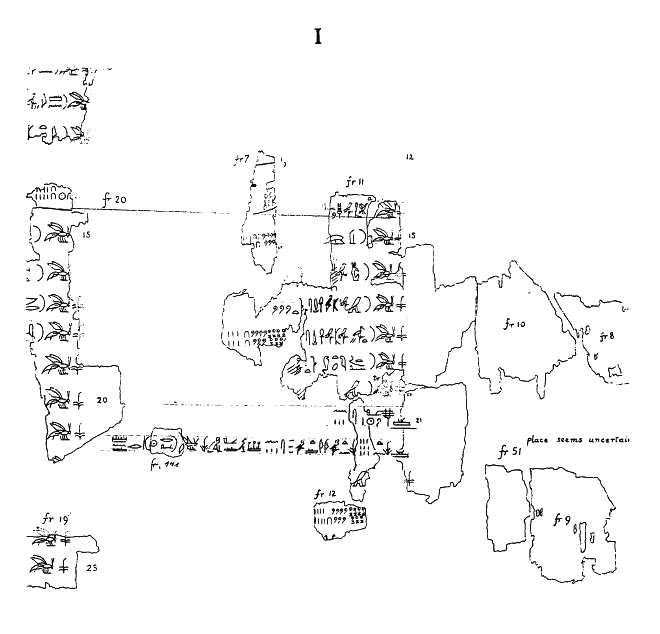
I do not consider it questionable that because line 14 ends with “omitted” contrary to the way the papyrus otherwise indicate months and days, because this is probably a temporally fixed mythical procedure, while in the actual king list these omissions indicate years of reign immediately following and possibly opposing kings, who are omitted for chronological reasons.
But from the knowledge that only 9 gods have been mentioned here, we may conclude that the usual assumption, based on Manetho, that Ptah was mentioned before Re in our papyrus, at least for the group to be summarized here, can not apply. Therefore, as Gardiner, we cannot accept the position of frgm. 7 as certain, and must move it down by one line.
The list of gods of Turin's papyrus, by not seeming to start with Ptah, is close to the list of Diodorus, whom also placed Helios (= Re) at the start. It is also significant that, as I have already emphasized Manetho 5, in historical references, it is never called the "time of Ptah," in contrast to Re, Osiris, or Horus. On the other hand, Manetho and the Royal Papyrus are linked by the fact that both (unlike Diodorus) omit the female members of the Heliopolitan Ennead. The Turin papyrus, however, fills the four vacated passages with other gods, namely Horus (thus, for Gardiner's reading " ? Since, however, the names apparently adopted in the Turin papyrus from the second dynasty of gods to the first differ in part differ from those handed down to Syncellos from Manetho; one should not draw too closely the parallel between the Royal Papyrus and Manetho. This certainly holds true for considerations of what may have been in the 11 lines lost at the beginning of Col. I. Nothing in the entire papyrus indicates that Ptah was even mentioned. But it can be seen from the classification of frgm. 4 in Col. II 8/9, that approximately in I 8 there was a number with hundred(s), since on frgm. 4 the characteristic "tail" of the hundreds is recognizable. So gods must have stood there too - probably primordial gods. However, which ones, is left to our imagination.
One must ask oneself the question of when dynasties of the gods were actually included in the annals. The Annals (Palermo Stone) list the prehistoric kings, which the Royal Papyrus then only summarized after dynasties. Thus, positions of the gods does not come from this tradition. As all traditions lists the Gods, one would assume that this addition has already been carried out in the original, on which the later traditions are based; as we shall see, this division of tradition can be set approximately in the Fifth Dynasty - that is, at the same time as the Annals was inscribed.
It might fit that they used the "dynastic origin of the world" theology of the Heliopolitan Ennead, on which Diodorus depended directly.
Another tradition then, at an indeterminable time, deleted the women from the Ennead; Manetho and the Turin Royal papyrus come from this line. But both differ in that the Turin Papyrus puts the gods in an Ennead with Horus, Thoth, Maat, and Har(oeris?). Horus is unproblematic; but Thoth with Maat and Har(oeris?), point to Hermopolis and Kus. In contrast, Manetho present a clearly Memphite tradition, since Ptah precede the Ennead.
The Ennead is not complete, as it comprise only six gods (with Ptah), but there is a "lesser Ennead", which however in its composition lists names like Tithoes and Sosis, which indicates that this must have been a very late addition, and for that very reason can not be expected in the Turin Papyrus. Therefore, we can see the following development:
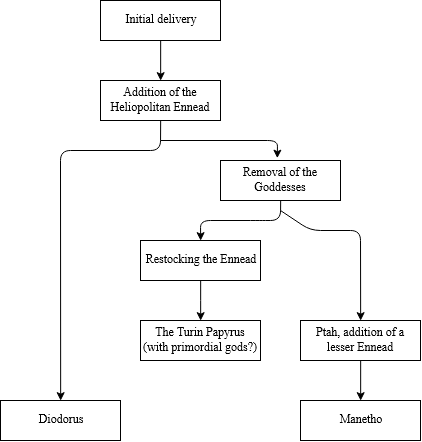
Column II: on the kings “before Menes”
At the beginning of Col. II with the information about the dynasties before Menes, several people have sought clarification. I myself tried Manetho, 6 ff., on the basis of the publication of Farina, Papiro dei re, to see the dynasties of gods in the data, which was certainly incorrect as it had already been shown by von Beckerath, MDAIK 14, 1956, 8 and Kaiser, ZÄS 86, 1961, 54 f. and further elaborated in ZÄS 91, 1964, 86ff.
Beckerath has now made an important observation, namely that the claum given in the Armenian tradition of Eusebius at the end of the list: "The reign of the spirits of the dead and heroes follows" is an incorrect assumption of a summation. But he did not realize that this summation must indeed have stood in line 8 in the Turin papyrus as well. Kitchen correctly saw, KRI II 828, 14, that there is room for another group before
Here it is very likely that frgm. 4 must be inserted, which bears the beginnings of lines 8 and 9, must be inserted. Because "lifetimes" appear only in "prehistory" up to Djoser - otherwise, I find no place for frgm. 4. Therefore, we can translate:
II 8 "Reign of the 'Spirits' and the Followers of Horus 13420 years."
II 9 "Their lifetime until the Followers of Horus 23200+x or 33200+x years."
The number 19 on the front side belongs in Col. VII 9.

Nb. The horizontal line obtained between the two entries of frgm. 4 belongs to a "100-tail" from the lost upper part of Col. I.
The fact that there must be a summation in line 1 of frgm. 4 (set by us = II 8) can be recognized by nsyt written in red ink! We have to assume that the Followers of Horus have already been mentioned before and that they do not appear for the first time in line 8 as previously thought. This could not have been in line 4, because von Beckerath is right, as he start a summation of the first 3 lines with
Also in line 5 can not be added at the beginning "Followers of Horus", because the gap is too small. This entry is already different from the others, because here not only after the years, months and days is accounted for, as otherwise in the actual king list, but also the smallness the numbers sharply distinguish themselves from the others with their thousands of years of rule. What is preserved after the gap at the beginning of the line looks like a city name, as expected in parallel to lines 1-3 and 6:
The interpretation and translation is, however, unclear, which von Beckerath, MDAIK 14, 1956, 8, transcribes "
First, the identity of the aforementioned city needs to be adressed, which Farina and Gardiner transcribe as . It is clear that this reading is influenced by the two
, which suggests an interpretation
for the signs above these two "
Gardiner however refers in his Grammar, Sign List M42, to the fact that the sign is "not distinguished from
Z11 in early hieratic, and replaced by the latter sign in MK hieratic, as also regularly in later hieroglyphic." But since the sign above the two "
, I think it is possible that
originally stood there, which was then changed to
out of ignorance of the spelling of
(
became
due to the identity of the hieratic signs for
and
and, finally, due to the similarity of the hieratic
with
, coalesced into
which was then quite naturally "corrected" to
.
One must not forget that the royal names of the First and Second dynasties received their present form within the papyrus through readings and reinterpretations of what they found. In addition, the tradition preserved in II 1-9 is, as far as the names are concerned, certainly good and very old, and therefore more exposed to such reinterpretations and readings.
However, is the group "(the) fortresses" the whole city or name, or does the
read by Farina and Gardiner belong before it? In any case, at the beginning of the line there must have been some kind of ruler's name. That was certainly not "Followers of Horus", but probably not
; only an addition to
would actually be possible, so that the city could have been called "Basher of the fortresses". One can use the term
Another possibility would be to see the end of the designation of rulers recorded in . However, there is an argument that neither a personal determinative nor plural lines are recorded. Against the second objection, one could argue that in the papyrus an indication "king + number" stands in the singular (see V 10.17, frgm 134.1 - here with addition of a place). In this case could be suggested to supplement
"fortresses [builders] 19...". I see no difficulty in the fact that the "spirits" and the "Followers of Horus" are clearly written in the plural; I have already said that line 5 falls outside the scope of the lines surrounding it, and that it also gravitate to the form of the actual king list.
However, what bothers me with this interpretation are the peculiarities of the present spelling: The missing personal determinative as well as the setting of the city sign behind the emended place wnt + wall determinative + plural sign, which indicates the name of a city.
So one will have to think of the first possibility, whereby it is completely unclear how the "lords" of this place were known.
On the other hand, the indication of the Followers of Horus can be easily completed at the beginning of line 6, the small difference of the writing compared to line 8, namely instead of
, should hardly matter. In the papyrus, however, a group follows that is described by Farina as "jmjw
", by Gardiner "
". The differently interpreted sign is partially damaged, but in Farina’s photograph, from which the differentiated reading as
or
can be derived. Like myself, von Beckerath, joined the reading of Farina and opened up a "papyrus thicket dynasty". However, Eusebius has given the correct indication that they must be "Thinites". Kaiser, ZÄS 86, 1961, 58, also emphasized this without, however, drawing a conclusion for the reading in the papyrus itself. The reading of the sign as either
, which is used to write Thinis:
For line 7 I can only refer to my suggestion in "Thinitenzei", 85, where it is assumed that they are king's daughters, who ran the government "for their father", whereby according to the preserved determinative of the "man with the Hand at the mouth" can be thought of as the supplement of
Line 10 is the heading for the kings of the Old Kingdom. However, it is not clear whether the "house" (
This list of "prehistoric" dynasties also includes some of the hitherto unordered fragments:
frgm. 2 probably belongs after a small gap in line II 2; the top of frgm. 1 connects to the end of line 3 received. The blank frontside fits with this arrangement.
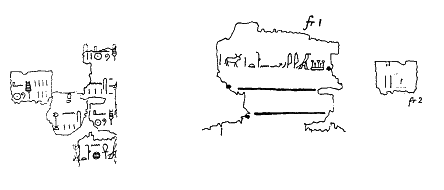
I suggest the following reconstruction of lines II 1-10:
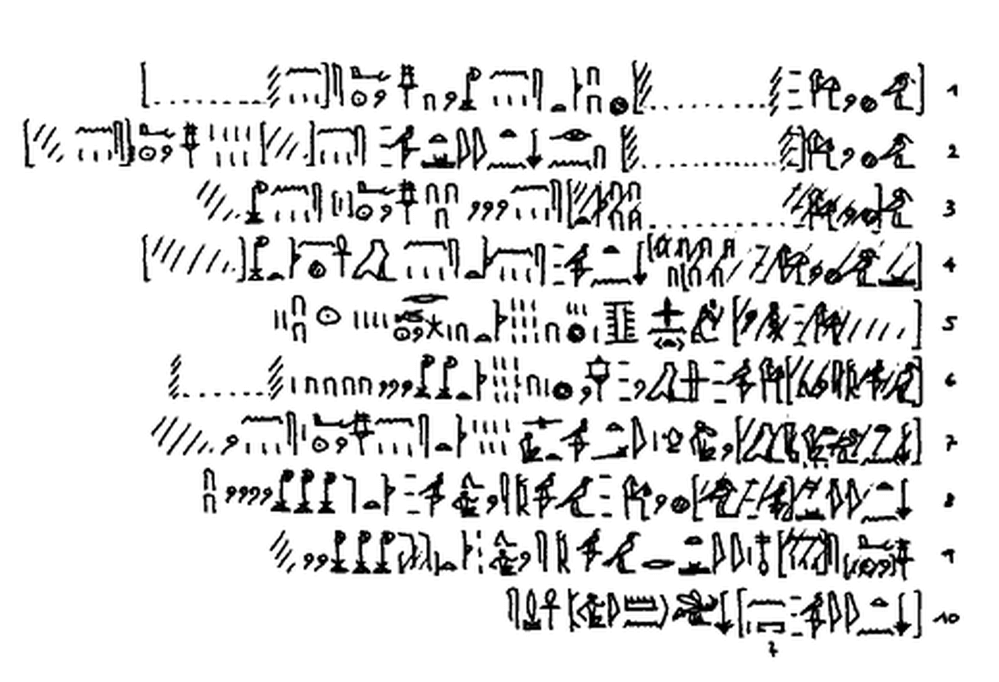
1. [spirits of the city .....] 20, their years 1110, their lifetime [.....]
2. Spirits [of the city .....] 10, their reigns years xxx7, [their] lifetime [.....] (frgm. 2)
3. Spirits [of the city .....] 40, their [years] 330, their lifetime 1000+x (frgm. 1 top)
4. [Total Spirits 7]0, their reign (and) their lifetime: years 1000+x
5. The [..... of
6. [The "Followers of Horus " who are in Thinis 19, years 2341, [their lifetime .....]
7. [Princesses] who represented [their father], women 7, their years (and) their years of life 100+x
8. Reign of the Spirits (and) of Followers of Horus, years 13420 (frgm. 4)
9. their lifetime to the Followers of Horus: years 23200 (frgm. 4)
10. [Kings of the Dynasty (
It is noteworthy that each entry is formulated differently, which actually contradicts Egyptian records.Thus, the agreement with Eusebius, as assumed by Kaiser, in: ZÄS 91, 1964, 86/7, is almost perfect from the text:
| Turin Pap. | II | 1 Eusebius: heroes |
| 2 = allii reges | ||
| 3 = allii reges | ||
| (4 Sum) | ||
| 5 = Memphites | ||
| 6 = Thinites | ||
| (7 Princesses) | ||
| 8/9 Sum = manes heroesque |
Especially with regard to the readings adopted in the pre-dynastic dynasties, the readings of the royal names up to "before Djoser" should also be briefly mentioned, for it appears that there is a secure tradition from Djoser on.
In the First Dynasty, the differences between the late tradition (the Turin papyrus, the lists of Saqqara and Abydos) begin with Horus Dewen, whose is the only one present in the lists. Here, the development of the writings of the Turin Papyrus and the list of Abydos has always been clear [Wildung, Rolle 29]:
Original to
(Wildung, Rolle 29 Anm. 8) to
(pTurin, pEbers, pmed. Berlin).
This is a simple reading of the hieratic model, where Wildung, Rolle 29, note 7, holds that the similarity of the signs was strongest, especially in the Abusir papyri.
It is important to note that the name of the Abydos list is , which can hardly be deduced from reading, rather than from a reinterpretation. However, there already seems to exist two different traditions in the time of Ramses II (and not an ad hoc "correction" by the author of the Abydos list), since Manetho knew both names, he must have used (at least) two templates for his list, as he give
= Kenkenes and
Usaphais (=
These two main traditions existed already in the Ramesside Period is also shown in the royal name . The Abydos list has preserved this almost unchanged,
indicating that this list represents the "best" of them. The Saqqara list have
from
(pAbusir:
) later interpreted as
(see Gardiner, Canon ad.loc.). Turin, however, clearly has
that must be a misreading of a hieratic
. So it is an individual error by the copier of pTurin; otherwise pTurin and Saqqara belong together because of the reinterpretation
to
. As Manetho’s Miebis indicate, the name has not changed in the subsequent traditions.
For Horus
The spelling of the name of the last king of the First Dynasty as
(pTurin, Abydos - transformed in Saqqara to
), is again easy to explain: Since the "upper arm"
-sign was written very high, it was recognized as
and from this the common word
The development of the name of the first king of the Second Dynasty, whose , represents a particularly obvious case of reading. Here, the evidence from the time of Ramesses II undoubtedly indicate two different transmissions: Abydos provides
, also known by Manetho as Boethos; Saqqara and pTurin preserve
. Manetho: Bieneches. Here I adhere to my opinion, already expressed in Manetho, 12, that an
as attested by Möller, Paläographie 52, X 552 note 1, from the Story of Sinuhe, that is, from the beginning of the Middle Kingdom, is one transmission of a tradition read as
("miner"), the other as
Wildung, Rolle 39, rejects this interpretation with reference to the writing palette Cairo JdE 37, 734 (op. cit. Fig. II and III 1), since it was found in a tomb of the Fifth Dynasty also dated to this period. Despite the impressive number of representatives of this communis opinio (Wildung, Rolle 39, note 2), I am convinced that this palette belongs to the Late Period – even a glance at the partly obscure hieroglyphics that can never be dated to the Old Kingdom makes such late dating almost certain. Therefore, if the king's name
The transmission of the name of is peculiar, in which the dissimilating pronunciation, which Manetho transmits as Binothris, appears in both traditions (except "
to
In this case, however, Saqqara stands against Abydos and pTurin, although we can no longer recognize "
Grdseloff, ASAE 44, 1944, 288 ff., has probably already given the correct explanation of the development in the fourth king of the Second Dynasty, which, however, is no longer present in pTurin: , in which case the "
(
Such a "modernization," apparently much later than wng, is evident in his successor , but certainly improves pTurin like Saqqara to
The transmission of the name of the last king of the Second Dynasty is strange. Again, the two traditions are separated: Abydos reads
, Saqqara
, and pTurin
. In all cases, two vertical signs standing next to each are visible and below them a small one, the starting point for the design, an arrangement also present in the original name. One can assume that
can be written very abbreviated as in the Abusir Papyri (Posener-Krieger and de Cenival, The Abu Sir Papyri Pal. Pl. XI p. 42):
, so that a reading of "
in it. The interpretation as "head" (Abydos) was obvious, if one had decided for a reading
It can be assumed that the kings referred to as "omitted" in III 2 and 7 at the same time as the readings just dealt with were considered unreadable and were indicated by "destroyed and omitted" (). This notation was then continued in both traditions: in the one leading to Abydos probably only
; while in the other tradition, an almost complete hieratic
with an
, the latter was assumed and reinterpreted as
, the bird to be read as
From what has been said, it would appear that the separation of the two lineages came about by taking two copies separately from each other, and by making various readings, as in the case of
Which interpretations one assumes remains open; but it seems certain that the separation took place not later than at the end of the Old Kingdom.
A brief comment is to be made on Gardiner's reading in II. 25, which expressly states that the middle sign of the name can not be as in VIII 25". At the place indicated, however, there is no indication that the name
, but "the comparison with the other records shows, however, that this is the only spelling available". In my opinion, not even a correction can necessarily be assumed, but in both cases, the sign is a very cursive
Column III
Regarding III 6b, Gardiner has presented a lengthy consideration of frgm. 40, in which he assumes that
Malek, in JEA 68, 1982, 102, has recognized that it is a normal entry, which also contains the fully written out phrase for an entry; with great certainty, he places the fragment in Col. IX. This will be addressed there.
Column IV
In the past the classification of frgm. 43 caused difficulties: Farina arranged the first line of this fragment with the name of Queen Nitokris as line 10, so that between the lines, containing the name of
[Phiops II]
[
Nitokris + (6 years omitted) - these correspond to 11 kings named in the Abydos list:
mn-kꜢ-rꜤ
nfr-kꜢ-rꜤ
nfr-kꜢ-rꜤ nbj
ḏd-kꜢ-rꜤ šmꜢj
nfr-kꜢ-rꜤ ḥndw
mr-n-ḥr
nfr-kꜢ-mnw
nfr-kꜢ-rꜤ
nfr-kꜢ-rꜤ trrj
nfr-kꜢ-ḥr
(These six omitted years are obtained from the summation of V 15).
jbj
[nfr-kꜢ-rꜤ]
[nfr-kꜢw-ḥr]
[nfr-jr-kꜢ-rꜤ]
The spelling of the names in V 8 and 9 (after von Beckerath's order) is striking. Gardiner’s reading of frgm. 61, I 4 as: 1 year and ½ month, is certainly incorrect. What he sees as
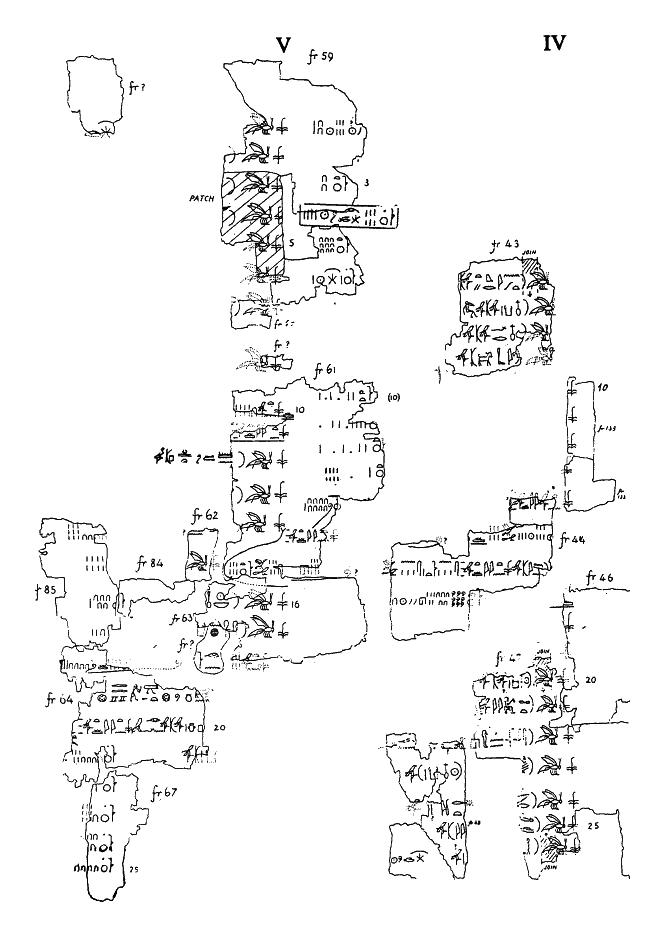
Unfortunately, the recto does not help with the placement of frgm. 43.
For the reading of the year in IV 4 (to against the "44 years" of Gardiner, see Helck, Manetho, 57.
Farina reads III 26 as "reign(s)" while Gardiner reads
"kings", see IV 14.
The small fragments 133 + 135 with the five "
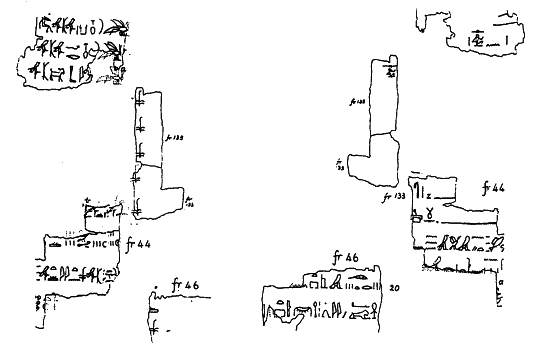
At the end of Col. IV, von Beckerath, in: ZÄS 93, 1966, 17 (recto) and 18 (verso) merged frgm. 46/47 and 38 + 48. This, as we shall see, is important for the further reconstruction of the papyrus and its template.
The summation in IV 14-17 reads:
14. [Total] Reigns [from king
15. 6 months and 3 days, omitted 6 years, total [187 years, 6 months and 3 days] reign
16. since Menes: their reigns, (i.e.) their years and omitted: [949 years], 9 [months] and 15 days, omitted 6 years
17. [Total since king Menes] 955 years <9 months> and 1[5] days.
The scribe must have forgotten the details for months in line 17; otherwise, the calculation is incorrect.
One can read from the calculation that in the sum of "Menes to Unas" in III 26 must be "768 years, 3 months, 12 days".
It is noteworthy that in III 26 and IV 14 ff., the number of kings is not mentioned as it is in subsequent summations.
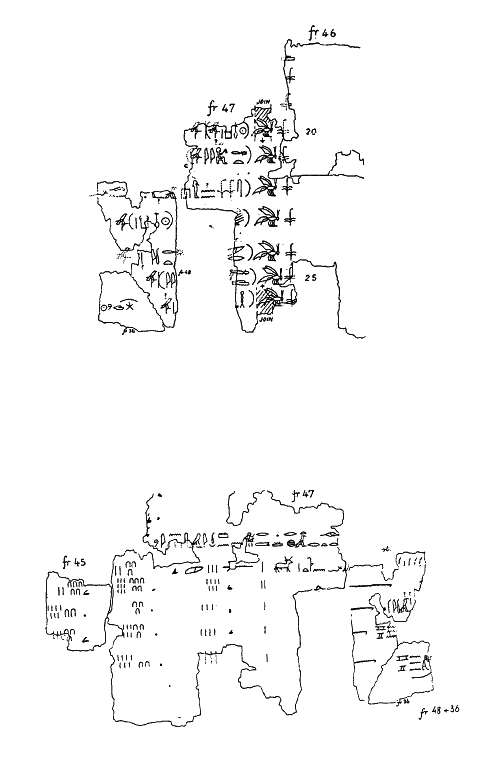
Column V: The individual readings in Col. V:
In V 12, Gardiner, who wanted to read a
"6 kings, amounting to years 1[36, omitted] 7, Total: 143".
A dynasty heading follows: "[The kings of the] residence
A particular problem is the arrangement of frgm. 67 placed at the end of Col. V and which is generally believed to hold the years of kings of the Twelfth Dynasty. It can be seen in the certain designation for
The successive kings have the following maximum numbers:
| Amenemhet II | "Year 35 corresponds to ( |
| Sesostris II | highest year is his eight (Stele at Toschke: ASAE 35, 1935, 71 pl. 2) |
| Sesostris III | highest date is 19 years (Geneva D 50; Dunham, Second Cataract Forts II, 33); In addition, on a Kahun papyrus (F 10055), the statement "year 19 = year 1" appears, which can be interpreted as meaning that Sesostris III had accepted Amenemhet III as co-regent at the age of 19. There are no double dating with his successor. |
| Amenemhet III | finally appointed his successor as co-regent in his 46th year, (see Franke, in: Or 57, 1988, 125); this is his highest confirmed date. |
| So we recognize: | highest number | pTurin |
|---|---|---|
| Amenemhet II. | 35 | 10/20/30+x |
| Sesostris II | 8+x | 19 |
| Sesostris III | 19 | 30+x |
| Amenemhet III | 46 | 40+x |
It follows that the order in the Turin Papyrus has been rearranged, either only the dates or together with a royal name, i.e. the numbers or the numbers + Amenemhets II name has been exchanged with those of Sesostris II and III:
[Sesostris II] 10 years + months and days
[Sesostris III]19 years + months and days
[Amenemhet II]3[5] years + months and days
[Amenemhet III]4[6] years + months and days
It is not possible to say how this notable change came about; only that the reliability of the papyrus is somewhat affected by it. D. Franke, op.cit., is probably right in assuming that one of the templates of our Turin papyrus, which was in the chain of tradition, once contained the data, for instance in the form:
King N.pr. Reign x years, y months, z days, co-regency x years, y months and z days.
In the course of the tradition, the full reign years were recorded but the co-regencies were not deducted. In the summation, however, the full years of reign and the years of co-regency (not subtraced, as intended, but) were added to the toal.
Correcting the changeover of Amenemhet II in the Turin Papyrus, the full reigns indicated are:
| Amenemhet I | (2)9 years x months and y days (According to "Sinuhe" Amenemhet I was murdered in his 30th year) |
| Sesostris I | 45 years x months and y days |
| Amenemhet II | 3(5-9) years, x months, y days |
| Sesostris II | 10 years x months, y days |
| Sesostris III | 19 years, x months and y days |
| Amenemhet III | 4(6-9) years, x months, y days |
| Amenemhet IV | 9 years, 3 months, 27 days |
| Sobeknofru | 3 years, 10 months, 24 days. |
This would result in the sum of the years indicated in Turin's papyrus as full reigns: 197-203 years (without the months and days that were not preserved). Assuming that the lost months and days of two governments averaged one year, we get three more years, i.e. 200 to 206.
The documented co-regencies are:
| for Sesostris I — Amenemhet II | 3 years |
| for Amenemhet II — Sesostris II | 3 years |
| for Sesostris III — Amenemhet III | 1 year |
| for Amenemhet III — Amenemhat IV | 1 year |
These are only the minimum figures.
If we assume with D. Franke that a copyist has mistakenly added these co-regency years to the full reign figures, we get 208 to 214. Thus we give the Turin totals of 213 years, 1 month, and 17 days, i. e., we may assume that in Sesostris II and also Amenemhet III the Turin Papyrus had registered higher numbers for the full reigns than we can verify through the monuments.
D. Franke makes a similar calculation, except that by his assumption that Sesostris I ruled for 10 years as co-regent of Amenemhet I (whereas the "teachings of Amenemhet I," as well as "Sinuhe," clearly speak against it!), he limits the co-regencies of Amenemhet II and III to the dates known to us from the monuments.
Column VI
According to the text of the recto, it is very likely that frgm. 75 is to be placed below 72 and between 74 and 86. This results in:
| year (x) | (month x) | days 23 omitted 6 years | |
| year 2 | (x) | 22 | |
| year 1 | 1 | 27 | |
| (x) | (x) | 12 | |
| (x) | (x) | (x) | |
| (x) | (x) | 4 |
It should be noted that fragment 75 fits exactly in the gap; neither a shift upwards nor downwards is possible, since then it would collide with fragments 72 and 71, respectively.
- VI 3 can hardly be completed other than: "Kings of the Residence [of
jt-tꜢwj , kings] 8, makes years 213, month 1, days 17"; so Farina, however, to be supplemented with Gardiner before the number of kings.
- VI 4 is to be interpreted as a heading for the subsequent kings, for instance in the form: "kings [who ruled] after [the dynasty of] king
sḥtp-jb-rꜤ ". Please note that "kings" (without figures) is written, "reign" however
After Gardiner recognized traces that unfortunately are unreadable. There was expected
as a designation of a "dynasty".
Despite these uncertainties, the meaning of this line can hardly be doubted.
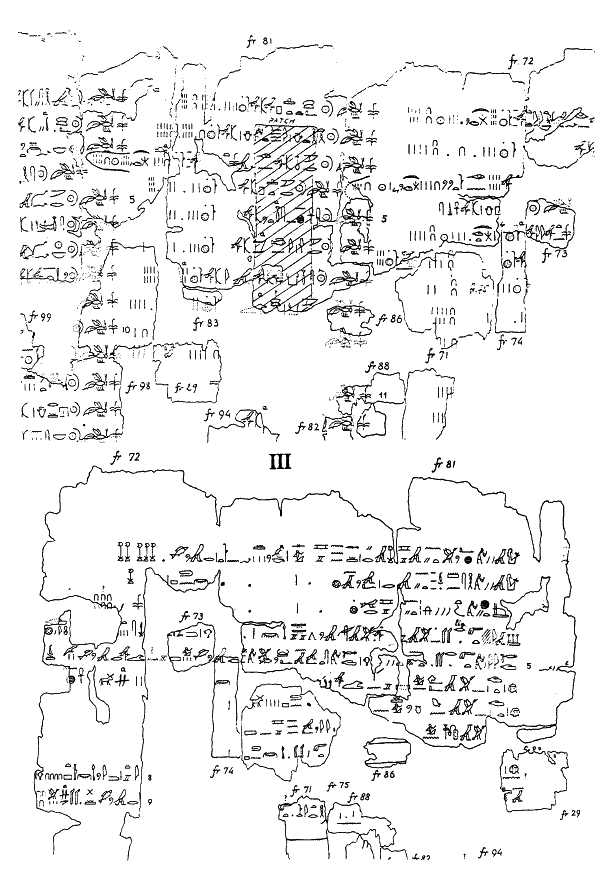
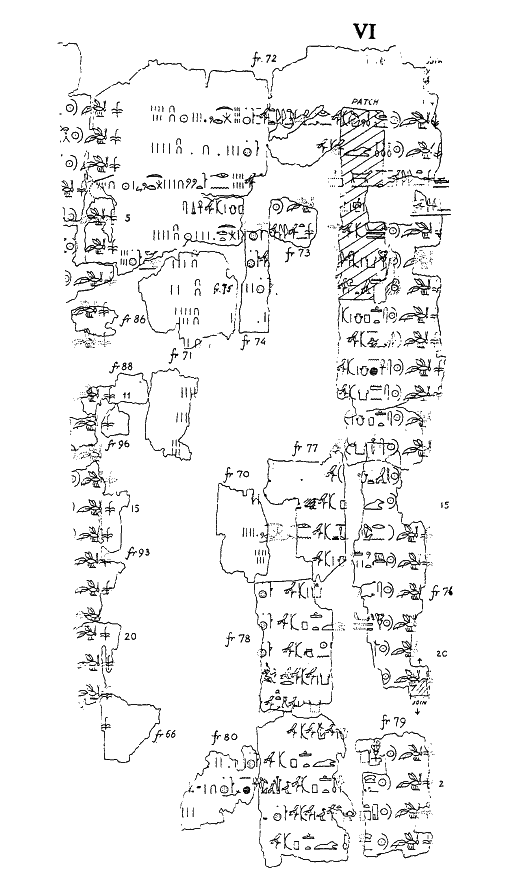
Column VII
According to the recto, the small fragment 29 may fit as line beginnings 10 and 11 on the recto Col. III, because "
Even frgm. 66, according to the recto, fits very well below frgm. 87, so that it may be placed there, whereby a direct connection of frgm. 66 to the penultimate line of 87 ought to be given preference, because this result in a clear explanation of the accounting of the recto.
Not certain, but as a possibility it should be considered whether the small frgm. 90 should not be inserted between fragments 95 and "?" in line 18 (verso). The remaining text on the recto is not very meaningful.
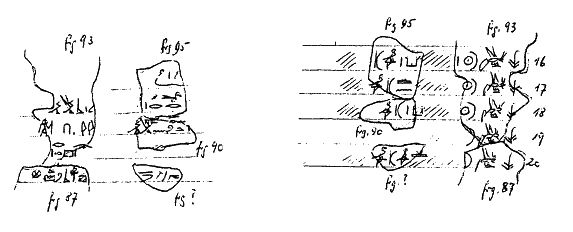
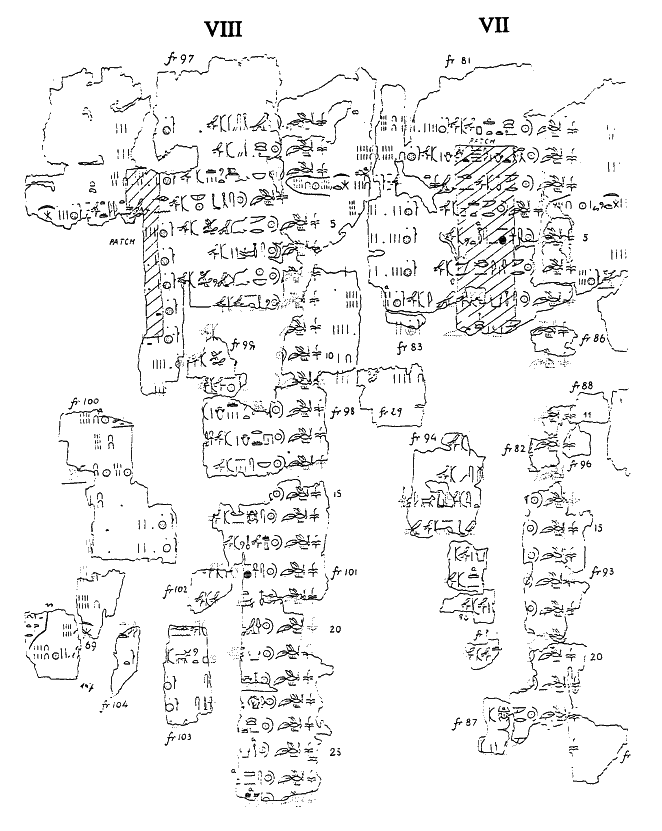
Column VIII
The only thing to note about this column is whether or not frgm. 147 may be the end of the long column of the recto of frgm. 151/2. On the verso one can recognize traces of the "month sign", whose beginning is on frgm. 69. The signs delimited by a thick stroke do not belong to the royal lists of the next column - what could it mean? - but is a notation as in III 8, which, however, is inexplicable: (so Farina).
Column IX to X
Gardiner expressly emphasizes in his publication that his arrangement of the fragments in his columns IX and X is largely unsecured - except for lines IX 1-10, which are determined by the textual context on the recto. Further, he points out that frgm. 41/2 stands on a patch usually found at the top of the papyrus. Nevertheless, he places this fragment at the beginning of the lower half of a column, which is certainly flawed.
In order to achieve a better arrangement of the fragments of Gardiner's columns IX (second half) and X, these patches should be considered, but also the so-called "full formulas", i. e. the writing of "King’s name, he reigned years x, months y, days z". As these lines become significantly longer compared to others, these details are often omitted or replaced by repetition marks.
Later, their appearance in the text is also to be used for the reconstruction of the papyrus - but initially the length of this line will be important in connection with the reconstruction of column widths.
In the part of the papyrus in which the columns are preserved in a secure context, it can be seen that the "patches" are 16 cm apart from the middle of one to the middle of the other - at least according Gardiner’s transcription, but which seem to correspond to the original after comparing the data to Farina p. 13. As column widths fluctuate, the "patches" lie at different places within the columns. The following sketch show the first eight columns:

The column width, i. e. the distance from nswt to nswt varies considerably. First we have to establish where the "patch" on frgm. 41/2 should be placed. It can be assumed that Malek, in: JEA 68, 1982, 102, has placed frgm. 40, contrary to the old placement in Col. II mentioning the wise Imhotep (see above), in Col. IX. Gardiner stated on p. 15 at III 6 that this fragment is written "partly over a patch", but unfortunately did not provide this "patch" on plate IX. This is not so alarming, because the position between this fragment and frgm. 108 results clearly from the recto, whereby the position of the "patch" can be calculated:

Malek's arrangement is thus secured:
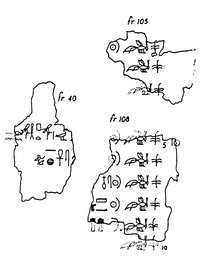
where a measurement of the "patch" in Col. VIII shows that the center of the patch obtained at frgm. 40 was located a little to the left outside the remainder obtained:
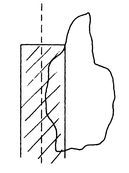
If we now assume that "patch" 40 was immediately followed by that of Frgm. 41/2, which would have occurred after 16 cm (calculated from center to center), then the initial edges of Col. IX and X would have been 22 cm apart:
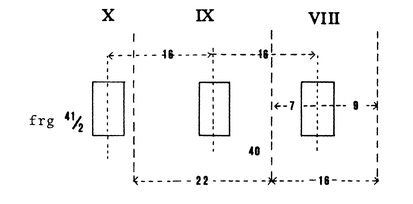
Leaning to propose to place frgm. 41/2 (patch) immediately after Col. IX (with patch frgm. 40).
However, such a column width is unlikely within the actual king list constellations. We have to accept one (or more) column(s) between Gardiner Col. IX and X. Theoretically, the following possibilities arise: a "short" solution, where the "patch" 41/2 is set immediately to "patch" frgm. 40, but two columns are placed in between:
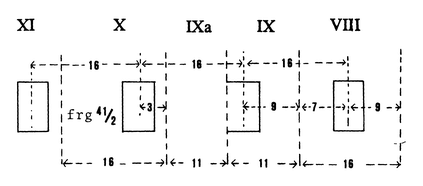
But this would lead to such narrow columns (11 cm each) that this is very unlikely; moreover it does not take into account that IX 5 must have been a very long line (because of the so-called "full formula" of a column heading in the original, see above).
Secondly, a "long" solution in which another "patch" is inserted between frgm.40 and 41/2:
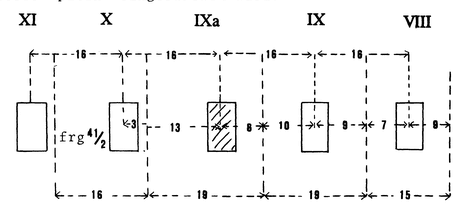
In this case two broader columns of 19 cm each are formed for IX and IXa, as in Col. III; here the "full formula" of frgm. 40 could find unhindered space in Col. IX; and the relatively large empty spaces of frgm. 150 and 151/2 could also be explained.
However, it is clear that at the end of the papyrus, the columns are tightly packed together and therefore two columns are 19 cm too wide. Therefore, it seems more likely to insert two columns between Gardiners IX and X, but only one "patch" has to be inserted:

This "patch" is also present: it is frgm. 50 that Gardiner placed among the unplaced fragments. This patch can only be placed in this place, because the only place in the papyrus a "patch" is otherwise missing is at the end of Col. III. The number of the days is preserved for the individual reign on frgm. 50.
For a more precise assignment of the fragments given by Gardiner in the lower half of Col. IX and Col. X into the new columns IX, IXa/b and X, a further possibility for determining the position needs to be drawn. Namely, the fact that our text is copied from a template in which each column began with the detailed textual form: "King X, reigned as king years x, months y, days z".
The subsequent lines then skipped the connecting words. Our copyist, though his lines were longer, copied these old column beginnings unchanged. The distances between the "long phrases" now standing within the columns must, understandably, be about the same length, as Helck, Manetho, 83f., has pointed out. However, Barta, GM 64, 1983, 11ff., rightly doubted the classification of exactly 16 lines, as Malek did it, because in such long papyri the column length or the number of lines within a column can change - usually the number of lines within a column increases towards the end. This is also evident in our papyrus, where the following number of lines can be found within a column:
| I | II | III | IV | V | VI | VII | VIII |
| ? | 25 | 26 | 26 | 25 | 27 | (27) | (30?) |
The following hints can be seen for each of the old column headings, in that either the "full formula" is still partly or completely preserved, but also that an "moved" number has been preserved, indicating that the associated line was longer than usual, which in most cases could indicate the presence of the "full formula":
| (I 1) to I 13 | = | 13 lines | = | I 1 is not preserved |
| I 14 to (II 2) | = | 14 lines | = | I 14 can be recognized by |
| (II 3) to II 16 | = | 14 lines | = | II 3 is no longer recognizable |
| II 17 to III 4 | = | 13 lines | = | II 17 can be recognized by rnpt; this is taken up in the following by repetetion marks. |
| III 5 to III 18 | = | 13 lines | = | "full formula" preserved |
| III 19 to (IV 6) | = | 15 lines | = | remainder of the "full formula" preserved |
| (IV 7) to IV 21 | = | 15 lines | = | IV 7 not preserved |
| (IV 22 to (V 10) | = | 15 lines | = | remainder of the "full formula" preserved |
| (V 11) to V 25 | = | 15 lines | = | formula not preserved, but note the red "dynasty" heading |
| VI 1 to VI 15 | = | 15 lines | = | "full formula" preserved |
| VI 16 to VII 2 | = | 14 lines | = | short phrase, but with |
| VII 3 to (VII 16) | = | 14 lines | = | "full formula" preserved |
| (VII 17) to VIII 3 | = | 14 lines | = | not preserved |
| VIII 4 to VIII 19 | = | 16 lines | = | "full formula" preserved |
| VIII 20 to ... | = | remnants of the "full formula" |
Until VIII 20, we can determine a secured sequence of the column headings of the original. For the rest of the process, it is important to classify the recognizable indications on "full formulas" recognizable on the two patch fragments 40 and 41/2, as well as the reference to frgm. 122/3, which because of the blank recto probably has to be placed at the end of a column. It can be assumed that the last secure indication of an old column heading of the template is present in VIII 20. The preceding column VIII 4 to 19 indicated that this column of the original contained 16 lines.
At the end of our papyrus, on Fragment 163, which Gardiner places after Farina in column XI at the end, in line 2 such a "full formula" of the column beginning of the original is preserved. This fragment can certainly not be placed anywhere else, since the only alternative place, namely the lower end of Column IX, is not possible because the frontside of frgm. 163 bears no text, which is required for verso of column IX.
But if we start from the likely assumption that the last columns of our papyrus contained 30 lines after Col. VIII, the two old columns VIII 20 and frgm. 163 line 2 can connect in the following way, assuming that frgm 163 indeed contain the last lines of Col. XI, because there is still free space at the bottom of the fragment:
| VIII 20 to (IX 4) | = 15 lines in the template |
| (IX 5) to (IX 19) | = 15 lines, see Malek's arrangement of frgm. 40 |
| (IX 20) to (IXa 5) | = 16 lines, missing |
| (IXa 6) to (IXa 21) | = 16 lines |
| (IXa 22) to (IXb 7) | = 16 lines |
| (IXb 8) to (IXb 22) | = 15 lines |
| (IXb 23) to (X 7) | = 16 lines |
| X 8 to (X 23) | = 16 lines |
| (X 24) to (XI 9) | = 16 lines |
| (XI 10) to XI 26 | = 17 lines |
It should be noted that in XI 1-9 there is no indication of a "full formula".
From this we can deduce that line 4 of the "patch" frgm. 41/2 must be the eighth line of column X. For frgm. 122/3, the lines IX 20, IXa 22, IXb 23 and X 24 would theoretically be possible, since the fragment belong to the end of a column because it is blank on the recto.
Fragment 151/2 shows in line with line 4 a traces of days figure from the previous column, which probably belonged to a "full formula", whereby also this fragment with its line 3 could be set with little room as IXa 22, IXb 23 or X 24. However, frgm. 122 and 151/2 are mutually exclusive.
Thus, although an approximate arrangement is given for two of the fragments available to us, it remains unclear in which column we may insert these and others. For this, a third clue should be used, namely the spelling of the king's titles within the individual columns. Especially the sign of the "bee" clearly changes its shape. Cols. II to V above generally show the same shape, although small differences are recognizable, so when in Col. III and IV the wings converge at the body, while they are parallel in Col. II. Starting from Col. V, just before the middle of the column, but especially in VI and VII, the bee shows a dropping back line and the legs are usually no longer connected. In VIII, the hind body is barely indicated anymore. In Col. IX, in the fragments safely assigned to this column, a new spelling suddenly appears: the nswt-sign has a long horizontal line, the bee's body is long, and the legs are usually connected; the head is barely formed, the wings are short and do not touch the body (in contrast to Col. VIII). In addition, the scribe has apparently used a thicker bulrush.
If we now look at the fragments that we have to arrange, it turns out that frgm. 112 is very similar to this writing of Col. IX above; if the bee's head appears as a "double head" here, then this is also recognizable in IX 2 and may be regarded as an individual possibility of the scribe. However, it should not be immediately deduced from this that frgm. 112 is to be placed in Column IX, since it is to be expected that this scribe might also have written another column. There must be additional evidence for a more or less secure arrangement.
If we turn to the patch 89 + (41/2), the sign of the bee is largely destroyed, but the nswt-sign is clearly written with a smaller horizontal stroke than in Col. IX, although the "bee" is certainly not the extremely small form of Col. VIII. With the "double head" form frgm. 122/3 fits well together with 89+(41/2), although unfortunately the rear part of the character is always destroyed. Quite apart from this, 122/3 cannot be placed in IX, since its line 4 would have to be = IX 20, but in this case the fragment on the recto is blank and the text would collide with the remains on frgm. 100 ("Amphora 1").
Frgm. 150 and 151 clearly belong together, since the bee is written quite characteristically: without abdomen, double head, small wings without body contact, as well as the nswt-sign with a slightly curved cross-stroke. Frgm. 151 has received on the right edge a number (day), the must certainly belong to a "full formula" of the preceding column, which is likely to be line IX 20, whereby the position of 150/51 is acertained in the lower space of IXa. Accordingly this cannot belong after IX because of the "bee"-form, moreover the large free space between the fragment and the preceding column would come into conflict because Col. IX moved very close to the line ends of VIII.
Also frgm. 22+? has the same spelling of the king's name as 150/1, so that these fragments could be transferred to IXa together with 150/1. On the recto there is a written notation, which is then further recorded by repetetion marks; this can be interpreted to the effect that frgm. 22 stood at the beginning of the column, although of course this can not be completely certain.
There are still the small Hyksos fragments (which are unnumbered), which also show no indication of their position. On the recto it can be seen that the fragment with the year 40 (certainly belonging to Apophis) is connected to the Hamudi fragment by a red repetetion stroke connecting both (it is not a hundred stroke, as Gardiner thinks, but flourish sometimes recognizable at the end a repetetion stroke). The fragment, which on the recto bears the information about "1 bowl", should show on the verso of the "8" from the sum of the Hyksos "108", which according to Gardiner could be recognized earlier still on the Hamudi fragment. Since no king title appears, his spelling cannot help us.
Finally, the recto must be consulted for the question of the arrangement of the aforementioned fragments. Gardiner has in his publication as a "third entry" a large arrangement from fragments 99, 100, 105 and 108, to which we have already been able to, with certainty, add the patch of frgm. 40 (following Malek). From the content it is clear that in frgm. 22 we have the beginning of lines 1-3 of this arrangement. In addition, as pointed out above, frgm. 150 + 151/2 merge with the title of the king. We may therefore also settle these fragments into this arrangement No. III, where it is very likely that the second line of frgm. 150 ("Poll tax of the deputy ...") belongs at the end of frgm. 100, in the group "Amphora 1".. It is now clear that the approach suggested above of frgm. 22 and 150 + 151/2 must be correct in the Col. IXa, because it is supported by the recto.
A look at the remaining fragments 112 and the Hyksos fragments shows that, in contrast to arrangement III, these are deliveries of fish (and birds), as is the case with the "patch" 41/2 and – due to the high numbers - can also be found on frgm. 50. However, as neither Frgm. 112 nor the Hyksos fragments show any further indication of their position, except that apparently the scribe of IX also seems to have written on frgm. 122, the arrangement is difficult.
After the recto, an arrangement of the verso in Col. Ixb seems most likely to me, perhaps between the two patch fragments 41/2 and 50. In this case, IXb would have started with the Hyksos names. On the recto, the accounts of fish on all three fragments would then belong together, without it being possible to say with certainty which of the individual lines belong to each other.
Frgm. 112, however, remains quite uncertain; after line endsan arrangement in Col. IXb is possible, but then in the middle of the column, so that the line ends of the recto do not collide with the free, blank recto of frgm. 122/3.
The small fragment 134 contains the remainders of a summation:
Total kings of
their reign .....
On the recto at the top is the traces of a line of text, read by Gardiner with a question mark as "1 (?) man". Since there is also a free space on the verso below the two line traces, it can be assumed that this fragment belongs to the lower end of the column. Searching for a suitable place, verso Col. I-VI will fail, because the column ends are preserved. In Col. VII the recto speaks against this, since there (frgm. 80) the accounting column is also preserved to the end of the papyrus and described, that the fragment cannot be placed in an existing gap under frgm. 66 + 87 as it contain text. Because of the same text on the recto, Col. vso VIII also fails. Col. IX has a large gap in the lower half of the column into which the fragment could be placed, with which the recto agrees. However, the papyrus clearly shows that the large gaps at the end of the papyrus are contiguous, cf. also Col. II and V! Therefore it is probable to place our fragment below 151/2 in Col. vso IXa, for IXb and X like XI are omitted because there was free space on the recto. Also, the slightly smaller signs of our fragment seems to fit the equally small signs of frgm. 150 + (151/2).
Unfortunately, the place where these kings are supposed to have ruled cannot be identified. This would have been important because - if our assignment is correct - the kings with the "fantastic names" would have been located here.
Column XI
The reading of the fragmentary names 1-9 is safe since Stock, 13th to 17th Dyn., 78 ff., Helck, Geschichte, 136 ff., also von Beckerath, Königsnamen, 81 ff., follows:
sḫm-rꜤ-wꜢḏ-ḫꜤw
sḫm-rꜤ-smn-tꜢwj
sanḫ.n-rꜤ
nb-jrj-(r)-Ꜣw II.
smn.n-rꜤ
swsr.n-rꜤ
sḫm-rꜤ-šd-wꜢst
But then there are divergences, namely because von Beckerath places Infet V
Therefore, I would like to mention the following kings, of whom the names are no longer preserved, but of whom are expressly stated to be five, i. e. that they belong together, arranged in the following manner:
sḫm-rꜤ-wp-mꜢꜤt jntf VI
nbw-ḫpr-rꜤ jntf IV.
v. Beckerath places
sḳn.n.rꜤ
Von Beckerath would like to include
On the classification of frgm. 163 and its importance for the arrangement of the fragments of Col. IXa and X see above.
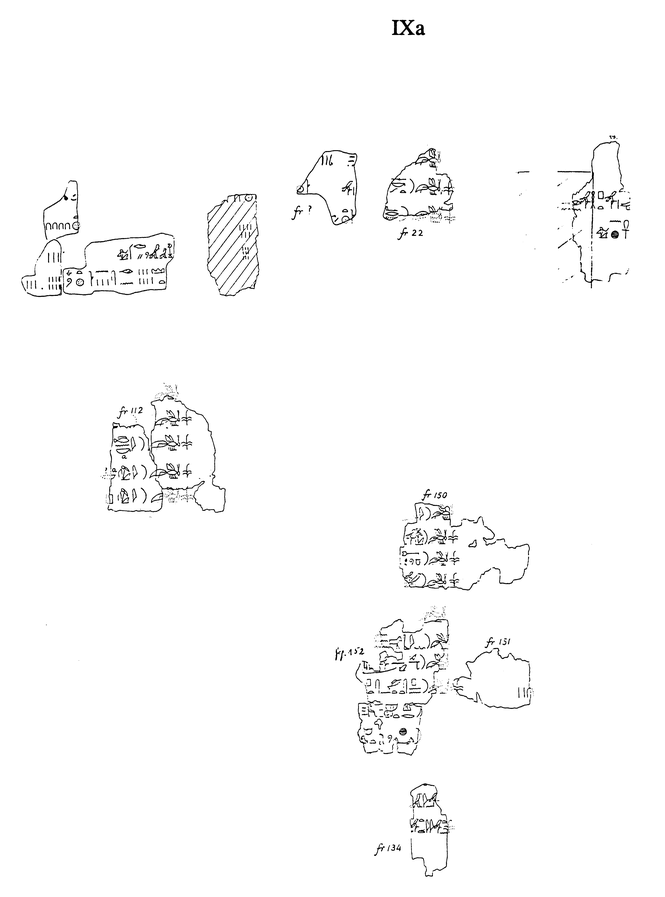
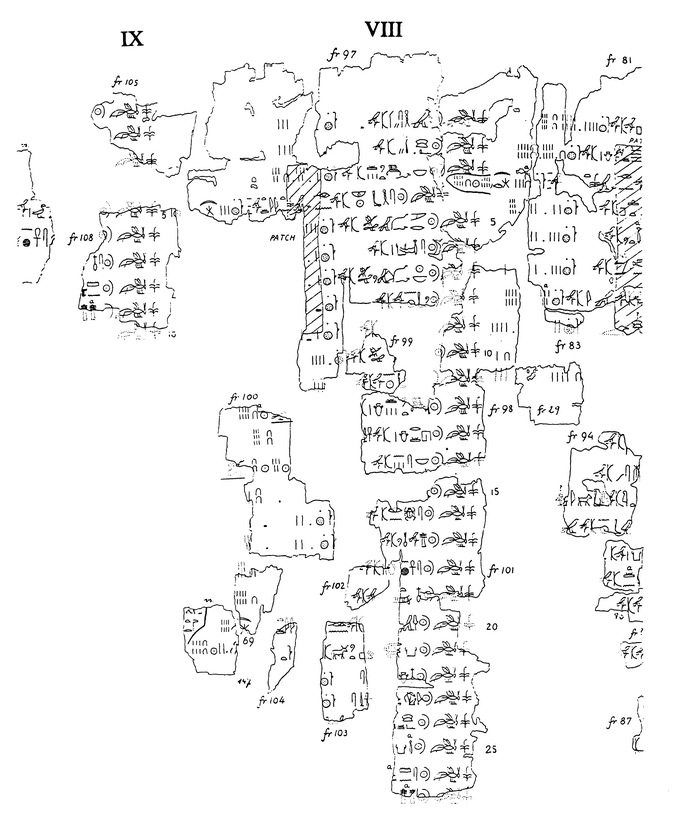
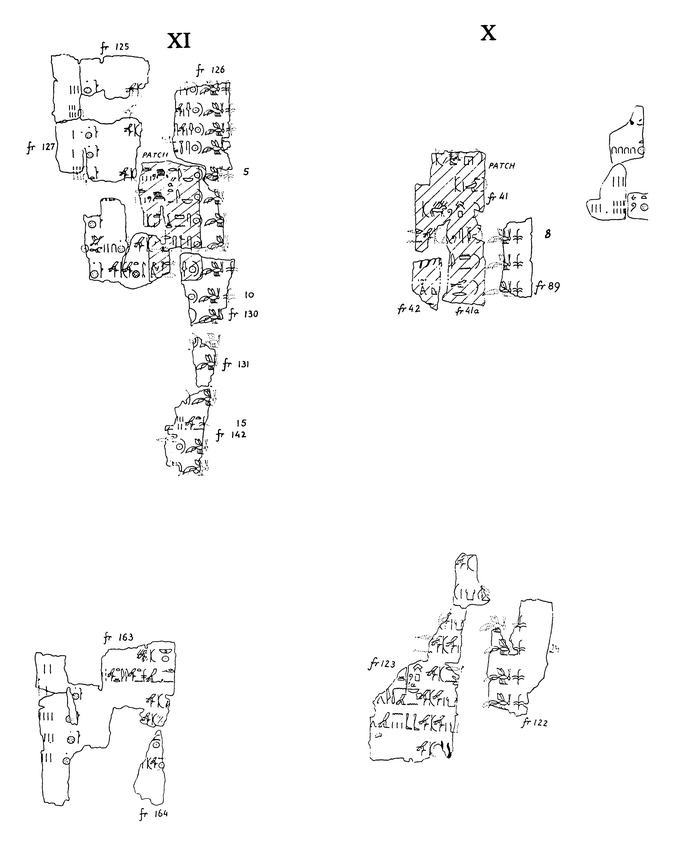
The recto
If it is unfortunate that the verso of the papyrus leaves many questions open because of the strong fragmentation, the destruction of the front is more unfortunate because it contains one of the rare state accounts. The information, if fully preserved, would have provided us with such necessary insights into the activities of the Egyptian treasury and the various taxes and dues that the state received. It is therefore necessary, despite the fragmentary state, to make at least one attempt at translation for the recto after the previously made changes and additions to the text.
Recto
I (41/2+89) + Hyksos frgm. + 50) The correspondence of the lines is quite uncertain! x+1 ........ / Thinis (repetition lines) / 2730 x+2 ..... 300, oipe(?) ..../ bowl 1 (repetition lines) /9590 x+3 ..... Silverdbn x / bowl 1 (repetition lines) /300+730 x+4 ..... Fish 30 000/ ... 1 bowl ...(?) Meaa-canal ... 130 x+5 ..... Silver (?), poll tax (of) ... (?) (gap) (112) x+6 ...................... (Hundreds) x+7 ...................... (Hundreds) x+8 ...................... (Hundreds) +30 x+9 ...................... 700, waterfowl 400 x+10...................... 85II (22 + 40 + 108 + 97 + 99 + 100 + 150 + 151/2) 1. [Mayor of] Faiyum, 1 person, his tax : [Silver kite 2].......... 1Salt (a) 1Coal10Rubber x Shortage (b): 9 additional duties (c) of his staff 2. [Suchos], 1 (person), (his tax):[Silver kite] 2........................ 1............ 20jnḥt-jug Grain (d) 1 (Shortage: 9 additional duties of his staff) (e) 3. ............. 1 (person), (his tax): (silver) x(?)jnḥt-jug Grain 1living rꜢ-goose 1 4. [People, their supplies:]... 1 It was issued: [Living Goose] 1[Asian cloth]ing 2 Shortage (b) [x additional duties] from their annual supplies: Asian clothing 12.....5. [The leader] of one half of the stonemason [troop], his poll tax:Silver kite 2..........[Salt] 1 for the year of the delivery He was issued 4 [years for] his [commission] (f)6. [x workers, their delivery (or similar)][living goose] 1Asian clothing 6 It ..... It was issued to them 4 years [of their] commission.7. ..... For silver-......8. ..... the young worker[s](gap)x+1 ..... on themx+2 ..... poll tax of the deputy of the ....:.......... Amphore 1x+3 lacunax+4 lacunax+5 .....: ..... 2pigeons 5 (ditto marks)10 (workers) (?)(empty)x+6 ..... of the reed worker(s) ..... (a)For the spelling see Wb III 82, 4. (b)see. Wb III 213, 12; written in red, probably a term ofadministrative speech. (c)It is probably Wb III 16, 9, but the determinative is unclear. (d)see. Wb I 99, 15? (e)This repetition is indicated by the vertical bars. (f)read sḥn : Wb IV 217, 1.III (Gardiner pl. VI) (+frgm. 75) (+frgm. 29) 1. The guardian of the flock of birds, which is at the Ihara(a) -canal: 1 man his annual tollfish 5000 2. The guardian of natron, who is in Ramuna: 1 man (his annual toll) (a) silver (!) dbn dbn 1, (fish) 1000 3. The carpet weaver, who is in the town mr-wr: 1 (man) (his annual toll) 60 ..... 4. Regular taxes of Suchos, the leader of both countries: Silver 1..... next to the ..... of the port(?) ..... 5. Regular withdrawal received from the fishermen of the lake of Suchos: fish 200,000; balance ... 6. Mayor's poll tax from the lake of Suchos ..... Silver x (e) ...-cattle 2 wn<dw>-cattle x, goats x 7. Poll tax of the deputy of the (mayor of the lake of Suchos) (c) (silver)dbn 4; ox 1 8. [Poll tax] of the scribes of the (mayor of the lake of Suchos) (at the "sea" of the "lake" (=Faiyum): 9. ..... (of) (the Mayor of the lake of Suchos) (c) : Normal [tax:] Silverdbn 1 10. List [of deliveries] ..... [of the po]rts: ½ where 40 kite silver for [each ship are (?)] 11. The ..... Normal deliveries ..... : various fish, birds (d) 30 12. ..... (Normal deliveries) ..... 13. City ferry (Normal delivery) (c) 14. poll tax of the mayor of ..... 1 donkey 15. What is with him for Pharaoh on the first of the third day? What on [him] is on the 10th: 1 donkey, 1 ox 16. gold (?) x, fish x ..... as (?) poll tax 17. ..... 18. (only letter remains) 19. One ..... for the 10 ..... (?) ..... 100 (baskets?) 100 substances [. . .] 10 ps breads 20. That which is with him for Pharaoh for] the first of the first prt: ..... Taxes of employees (smdt) ..... 6 [people], each 6dbn ... 450, total 4xx 21. ....... Elephantine. 22. ...... in the harbor...... 23. [dues] of all ports in the southern half of the administration .... [Taxes] of all employees of the port of Memphis: 1dbn ... .harbour ship . 24. [The..... ] Natron,dbn 2100 (+x) ....... silver ...... 25. .....; the antelope bringer ..... Scribe 50, makesdbn x 26. ...... 10 employees of the ....... (?) of the scribes: makesdbn x makesdbn x 27. ..... ..... 5 black skins 5 28. ....... [5] Metal hands each 20, makes 100 Wooden whips 5 29. ...... (a)Indicated by repetition stroke. (b)Indicated by repetition mark. (c)Indicated by repetition stroke. (d)An inexplicable sign. (e)Both lines 2 and 6 contain only the "gold"-sign with a gap in front of it; it is safe to assume that the "HD"-sign" in front of it has to be added each time, but this also affects the repetition mark in line 7.IV (top of 58 + 50 + 18a) Nb. if we may use Gardiner's order on pl. VII as a basis, at least the uppermost lines were written somewhat diagonally to the top left. 1. Fishhauler, 1 man ....... [fish] 3000 2. charcoal [.....on] each shore of the temple of Amun in the southern administrative area: 3. The inspector of the riverside estates 4. The Great [of the House] .....; his [poll] tax 2dbn silver 5. The manager of the [Gardens?] ..... 6. Poll tax 7. Rubber ...... 10 8. ....... 9. ....... 1 for 1 man 10. ........ (1) man 11. goat fat ..... 12. This year cattle crossing to ...... 13. Poll tax for each of them by .... 14. The hunter and ½ boy ..... 15. The hunter of ..... 16. Eye make-up worker ..... (ditto) ....... 2, makes x 17. Greenstone haulers .... (ditto) greenstone x ..... the commander of the fortress of ..... 18. This year: [Birdcatchers and] Fishermen who live on the water of the [Re] are: ..... tpj-fish x total 2 bags Poll tax ....... 19. makes smashed (?) x8 Their harvest tax for the year: Fish x 20. Normal tax of the head of the fortress of Semneh ...... ..... the ....., made at the place of the ..... 21. Poll tax of everyone in the ..... The policemen 2 kite silver 22. ..... (..x silver kite) (a) 23. ..... x (silver kite) (a) 24. ..... (to make) a personnel list of the rest of them, by ....... 25. ..... his annual [tax]: 1 bovine (goats?) (b) delivered debit balance 3 32 [29] 26. ..... (his annual tax) 2 DeliveredDebitBalance 7 59 52 27. ..... from ... ata (his annual tax) 1 3 30 27 28. ..... from ...-canal“ “ 1 4 36 32 29. ..... from ...-canal “ “ 1 4 27 [23] (a) Indicated by "ditto" dot. (b) The goats are probable because in the first entry indicated only by a vertical "ditto" dash.V (34) 1 deliveries that were with them: 2 [loaves], various 3000 3 "10101 4 "5230 5 "6400 6 "4800 Nb. This entry is to be separated from that in IV and not, as made in materials 471, to be associated with it!VICattle (goats?)Delivered(debit)(balance) 1..... his annual tax1x(continuously lost) 2..... “ (1)x 3..... “ (1)x 4..... “ 1x 5..... “1- 6..... “14 7..... “1619 (frgm. 4) 8..... “12 9..... “1610..... “1511..... (God) “1312..... “1213Pa[pyrus hauler] “11014the elder (?) ..... “1115[Installation (tp n ?) of] Tax [for Kush:]16[King's son of] Kush “xx17[Deputy of] [Kush]x3618[month x] 10 days T[ax] [10]2010 (b)19Gold[hauler] ....x67x20...... from Taj[a....]x27x21..... from .....-canal pidgeons 730022[Senior pol]ice .....23[poll tax of the] overseer of the estuaries24[poll tax] of each of the mayors of [the southern administrative district?]...25Poll tax of the deputy [the mayor?]..... (tree product)26[Dispatch of] policemen from ... (to) ... Eye make-up (!)(c) .....27[Dispatch of po]licemen from ... (to) ...28[Dispatch of po]liceman from ... (to) ... Delivery (?) ....29[Dispatch] of policemen from ... (to) ...30Poll tax of the inspectors .....31[The] inspectors ofwsr-mꜢꜤt-rꜤ -[stp.n-rꜤ .... .... 2, gaja-wood 36, eye [make-up] xVIIx+1The inspector of wells [ofrꜤ-ms-mrj-jmn which is inḫꜢ-si-n ] ..... (d)x+2The inspector of Migdol [ofrꜤ-ms-mrj-jmn ] .....x+3The inspector of wells [ofrꜤ-ms-mrj-jmn which is in aab-sa-q-bu] .....x+4The inspector of wells [ofrꜤ-ms-mrj-jmn which is in ha-bi-r-ta] .....x+5The inspector the wells ofrꜤ-ms-mrj-jmn which are in bi-r-[bi-r-ta] .....x+6The inspector of the fortress ofrꜤ-ms-mrj-jmn which is inḥa-sa-n .....x+7List of deliveries of the southern and northern oases:x+8Oases, southernx+9 ...... 1 man, 1 boy ...x+10...... 1 man, “ ...x+11...... 1 man, 1 “ ...x+12...... 1 man, 1 “ ...x+13...... 1 man, 1 “ ...x+14...... (1 man, 1 “) “ Wine 12 amphoraex+15................... “ kuja fruits 22 oipe psn bread x (a)"Kush" is indicated by repeating marks. (b)Here, apparently, the cattle entries stop and recording of the goats (?) has moved to the beginning of the line; line 19 speaks for the interpretation put forward, in which a smaller number stands behind a larger one, to which the received beginning of this calculation is to be compared to Col. V. (c)Read (ms )dmt . (d)For the additions to the well names cf. their lists in Pap. Anastasi I 27 as well as in the set of etchings on the northern outer wall of the hypostyle room in Karnak, s. Helck, Relations2, 310 ff.
About the text of the Recto.
Column I
At the beginning of the text only remains of an accounting of fish and waterfowl are preserved, which hardly tell us anything. If the reading on the larger Hyksos fragment is correct (and the placement is correct), then we are in the area of Thinis. Also, the so-called Head and Hand tax of an official, which is an "poll tax", i. e. the officials have to hand over an official tax, probably from their salaries. This tax, which is not otherwise abundant, is mentioned in the inscription on the wall between the seventh and eighth pylons in Karnak in the inscription of High Priest jmn-Htp of the late Twentieth Dynasty (Helck, MIO 4, 1956, 162) as "Amun’s maintenance", who is then again due to the king. As "Pharaoh’s maintenance" such supplies then go e.g. into supply for the workers of Deir el-Medineh (Helck, Wirtschaftsgeschichte, 148). According to Jac. Janssen, in; JEA 77, 1991, 79 et seq., Esp. 87 (v), this designation is found in Pap. BM 10401 and dealt with in detail, whereby he also regards the interpretation as an official tax as the closest one.
Column II
Unfortunately, only the upper part of this large account is preserved. We are in Faiyum, as the mayor of Medinet el-Faiyum and the chief god of the village Suchos are mentioned in the beginning. At the beginning it concerns the
It is remarkable that tax debts are waived for them here.
It is worth to mention the standard tax levy on Asian clothing. Remember that we know that at the royal palace in Gurob, Asian women wove clothes.
The length of assignment of the workers is pointed out. This shows that they - as we know from Deir el-Medineh - could be hired on a temporarily basis.
Column III
The entry filling the whole column clearly concerns the Faiyum. Not only the poll taxes of officials are registered, but also "labor performed" (
The "guardian of the axw" is of course (because of the determinative) not a "guardian of the melting fire", but has to do with the birds. However, it is not a well-defined bird (so Wb I, 224, 11; Caminos, LEM 127 to pAnast., IV 16, 1), but it follows from the Nauri decree (KRI I 47, 15
The first three mentioned: Guardians of birds, Guardians of natron and carpet weavers must deliver their products (according to the requirements) completely, which is why this delivery is called b3kw. The fact that the Guardians of the birds delivers fish in the process is probably becuse he is also a fisherman. But the specification of 1
Unfortunately, I cannot complete what the carpet weaver delivers.
Line 4 shows that the sTemple of Suchos pays "normal taxes", so is not exempt, as sometimes assumed. For this see the comments by Jac. Janssen, in: JEA 77, 1991, 92/3.
It should be noted that there is a remainder after line 5 of a "regular withdrawal" (here of a fish from the hand of fishermen), i. e. a withdrawal differs from a full delivery (
In line 6, Suchos probably bore the same epithet as in line 5. Again, as already stated, a silver tax is certainly to be accepted as a poll tax and not one made of gold. A red number, as can be seen in Col. V, refers to "cattle". This seems to be a record exercise, as it also occurs in pBM 10401, which surprises Jac. Janssen, op.cit., 87 (w).
Line 10 could relate to port duties.
In line 14 there must have been another mayor registered than that of Medinet el-Faiyum, perhaps that of Kahun-Gurob (
Smdt, i.e. the not assessed lower officials of an institution paid normal taxes (
Columns IV/V/VI
Despite its strong fragmentation, the large list shows that tax levies (initially probably "poll taxes") of individual minor employees were registered. The localization of the people is unclear. Towards the end however, one has the impression of being in Nubia: the eye make-up worker is reminiscent of a papyri of the Twentieth Dynasty, which deal with the procurement of eye make-up from the Nubian area (Helck, in: JARCE 6, 1967, 135 ff.). The diggers of greenstone (serpentine) also fits. After that fortress leaders appear, among them the fortress Semneh. But then a tabular list begins, which continues in VI and apparently registered the annual tax for a number of people, whose names are lost throughout. It is always about 1 cattle and a larger number of units, which were apparently delivered in installments, because "delivery - debit - balance" is settled. Unfortunately, it is not possible to determine what these units are (the "goats" used are only guessed at). But as soon as this list expressly turns to "Kush", the cattle disappear and the "goats" (?) alone remain. Now police units appear, summarized with "from - to". Unfortunately, no topographical name is preserved here either, but they are certainly Nubian units.
A small list is inserted in IV and deals with production deliveries (
The big list goes then abruptly in the penultimate line of VI to control list of "inspectors" who apparently – all follows in the continuation on VII – were on duty at the Way of Horus.
Column VII
The enumeration of the individual well stations seems to be largely in line with official lists, as they appear in the campaign depictions of Sethos I on the northern outer wall of the Hypostyle Hall at Karnak and in pAnastasi I. Unfortunately, there is no indication how the poll tax was delivered.
The last entry of this list refers to deliveries (
Overall, one has the impression that this papyrus was for the most part concerned with delivery of the most diverse taxes from the outskirts of Egypt: the Faiyum is listed in detail, then Nubia, the Way of Horus and the oases. In addition there are taxes from the traffic on the Nile. If one disregards an uncertain mention of Thinis, no places in the country itself are mentioned by name (Elephantine may already be considered a border area to the surrounding countryside). So it seems that the Treasury had its own offices for deliveries from the surrounding countryside, from which this papyrus originated.
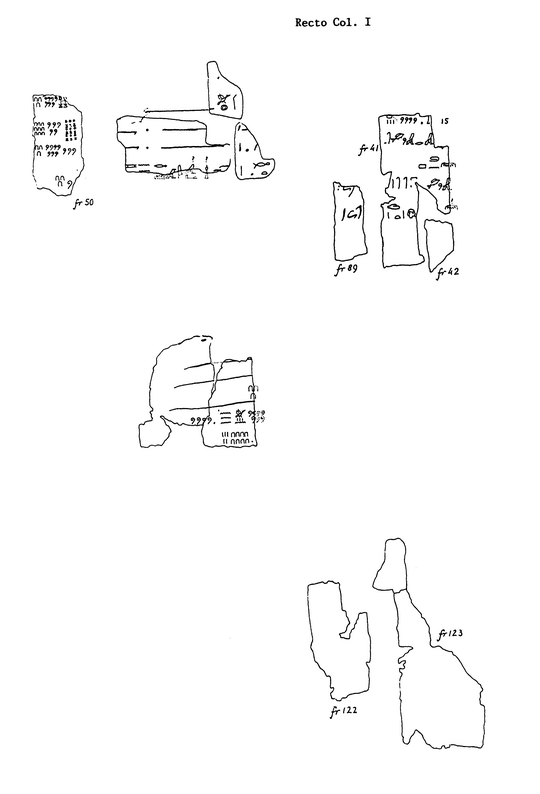
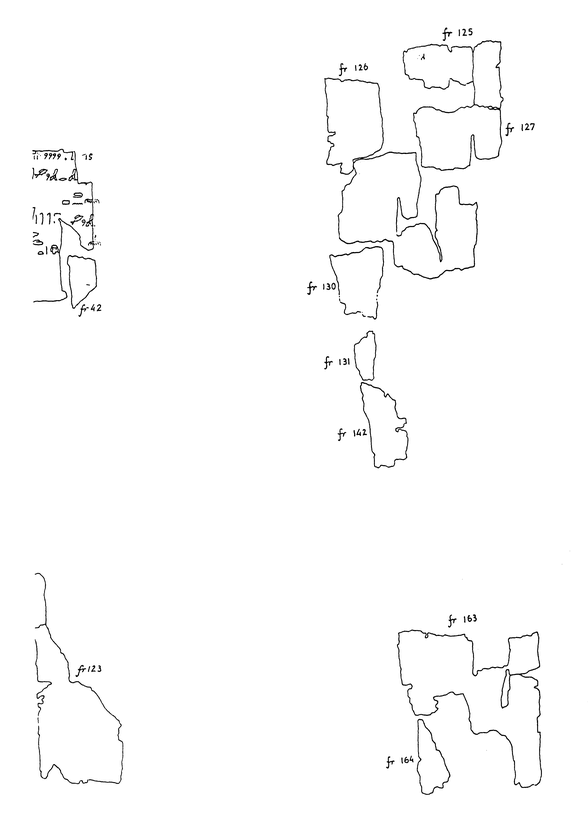
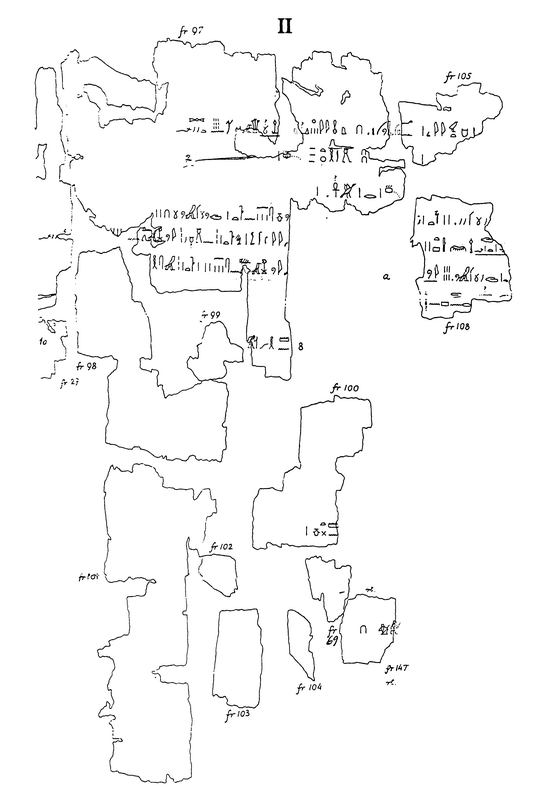
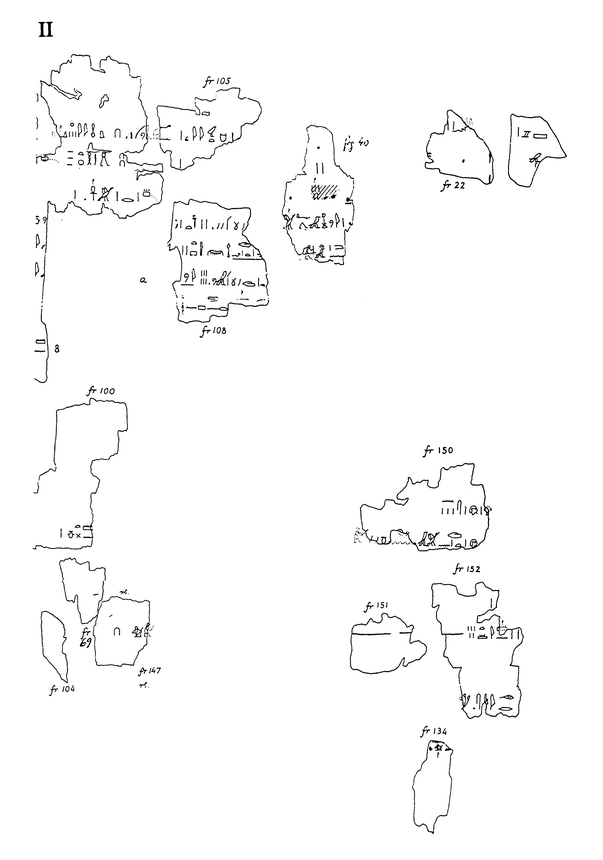
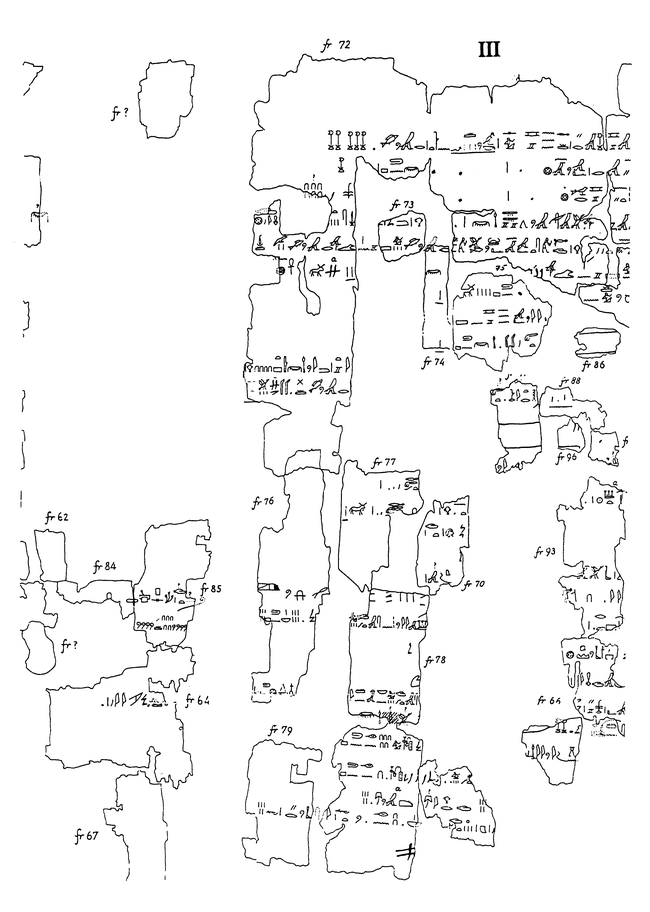
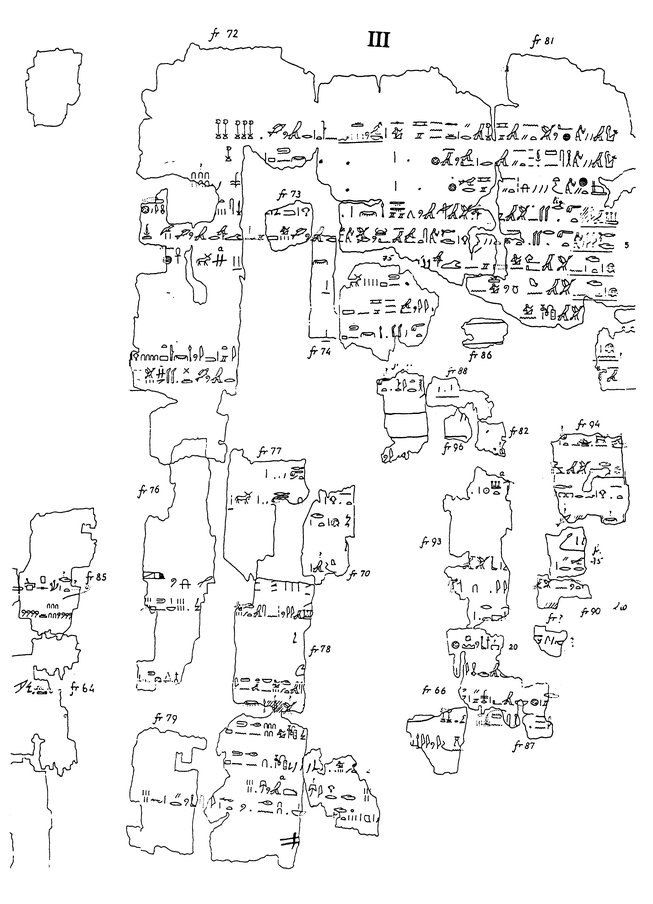
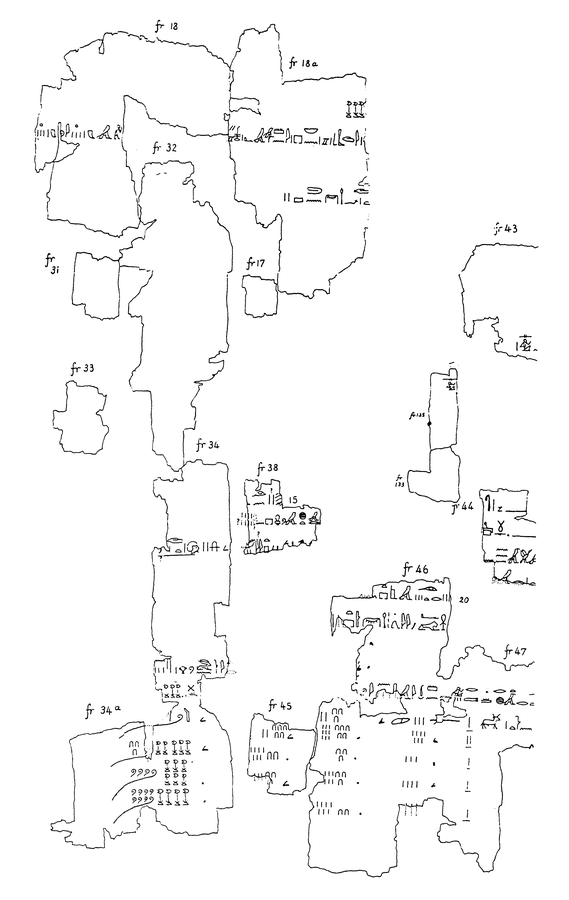
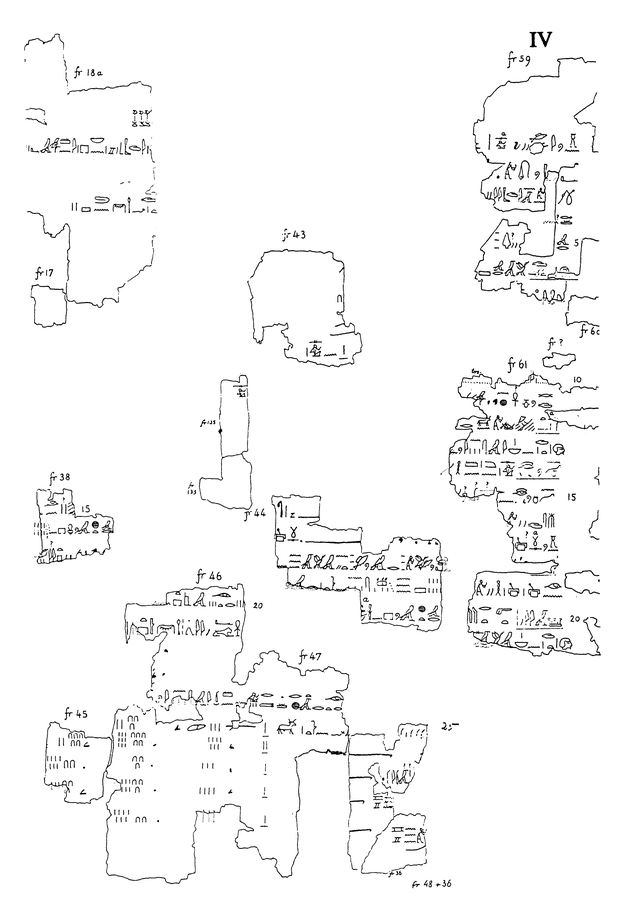
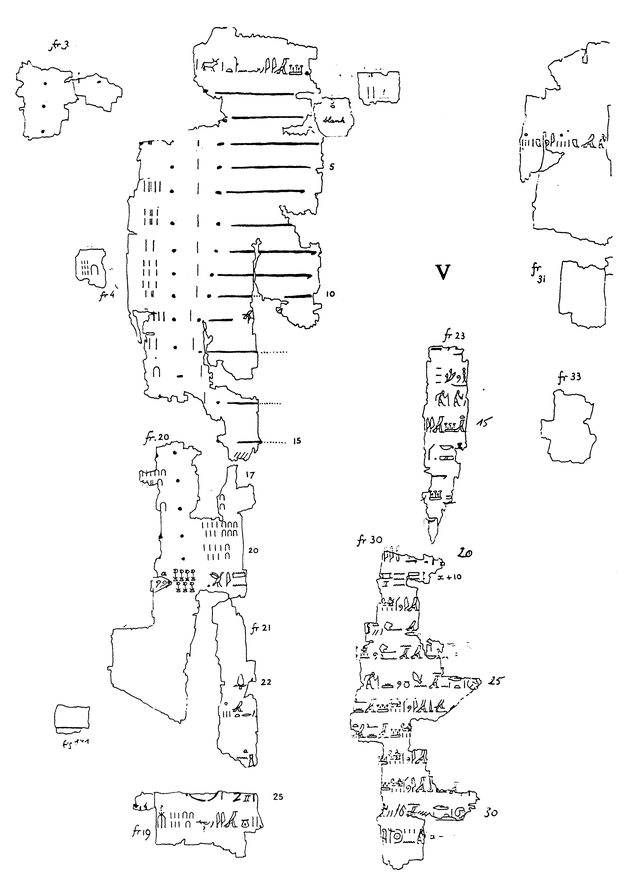
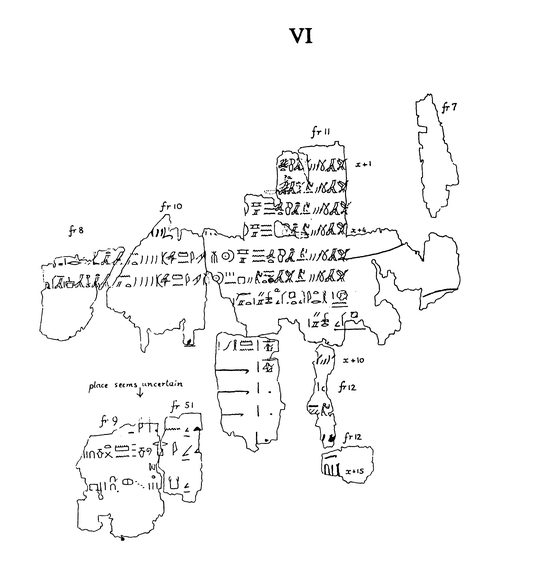
Appendix: The form of Summations and Headings
The summations have the following form:
| # | Summations | Headings |
|---|---|---|
| 1 | I 21-24: | |
| 21. Total their [life[time [..... | ||
| 22. Total [Kings] 9 [Reign of King Re to] | ||
| 23. King Har[oeris]: x years, y months, z days, omitted x years | ||
| 24. [Total x]7718 [years] | ||
| 25. [Spirits after the Gods] | ||
| 2 | II 8-9: | |
| 8. Reign of the Gods and Horus: Years 13420 | ||
| 9. Their lifetime until the Followers of Horus: 23200 years | ||
| 10 [kings of the House of] king | ||
| 3 | III 26: | |
| Total reigns from Menes to [Unas: 768 years, 3 months, 12 days] | ||
| 4 | IV 14-17: | |
| 14. Reigns [from king | ||
| 15. 6 [months] 3 days, omitted 6 years, total reigns [187 years, 6 months, 3 days] | ||
| 16. [by] Menes: Their reigns their years and the omission: [949 years] 9 [months] 15 days and 6 years omitted | ||
| 17. [Total since king Menes] 955 years, <9 months> and 15 days | ||
| 5 | V 10-11: | |
| 10. Total 18 kings [..... | ||
| 11. [their] reigns [..... | ||
| 6 | V 17 [Total] kings 6 makes years [136] omitted years 7, total 143 | |
| 18. [kings of] the residence | ||
| 7 | VI 3: Total kings of the residence [ | |
| 4. Kings [that reigned af]ter [the House(?) of] | ||
| 8 | IX 26-27: | |
| 26. [King]s of | ||
| 27. [their] reigns [..... | ||
| 9 | IXb 9: [Total Hyk]sos 6 makes 108 years, 3 months, [x days] | |
| 10 | XI 15: Kings 5 [..... |